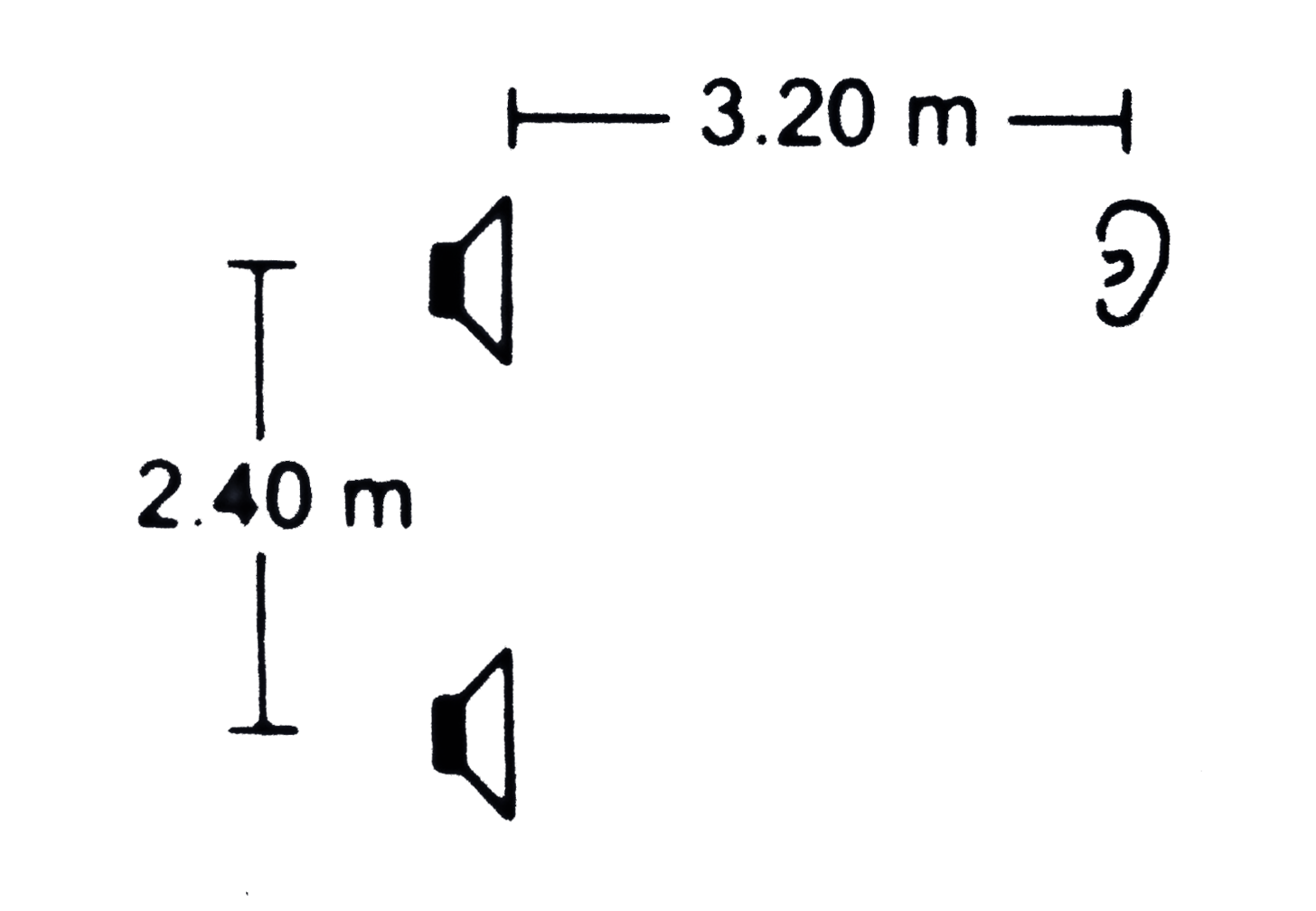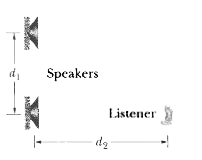Two loud speakers are located 3.35 m apart on an outdoor stage. A listener is 175 m from one and 19.5 m from the other. During the sound check, a signal generator drives the two speakers in phase with the same amplitude and frequency. The transmitted frequency is swept through the audible range (20 Hz to 20 kHz). (a) What is the lowest frequency that gives minimum signal (destructive interference) at the listener's location? By what number must be multiplied to get (b) the second lowest frequency that gives minimum signal and (c) the third lowest frequency that gives minimum signal? (d) What is the lowest frequency that gives maximum signal (constructive interference) at the listener's location? By what number must be multiplied to get (e ) the second lowest frequency that gives maximum signal and (f) the third lowest frequency that gives maximum signal?
(a) 2.0 m , (b) factor of 3 , (c ) factor of 5, (d) 172 Hz , (e ) factor of 2, (f ) factor of 3
Topper's Solved these Questions
- WAVE - IIBOOK - RESNICK AND HALLIDAYCHAPTER - WAVE - IIEXERCISE - PRACTICE QUESTIONS (SINGLE CORRECT CHOICE TYPE)
35 Videos
- WAVE - IIBOOK - RESNICK AND HALLIDAYCHAPTER - WAVE - IIEXERCISE - PRACTICE QUESTIONS (MORE THAN ONE CORRECT CHOICE TYPE)
6 Videos
- WAVE - IIBOOK - RESNICK AND HALLIDAYCHAPTER - WAVE - IIEXERCISE - CHECKPOINTS
4 Videos
- VECTORS BOOK - RESNICK AND HALLIDAYCHAPTER - VECTORS EXERCISE - PRACTICE QUESTIONS
39 Videos
- WAVES-IBOOK - RESNICK AND HALLIDAYCHAPTER - WAVES-IEXERCISE - Practice Questions (Integer Type)
4 Videos
Similar Questions
A bell is ringing inside of a sealed glass jar that is connected to a vacuum pump. Initially, the jar is filled with air, What does one hear as the air is slowly removed from the jar by the pump?
View SolutionCoherent sources are characterized by the same
View SolutionWhen the oscillating air element is moving rightward through the point of zero displacement , is the pressure in the element at its equilibrium value. Just beginning to increase or just beginning to decrease ?
View SolutionWhich one of the following statements is true concerning scalar quantities ?
View SolutionA progressive and a stationary simple harmonic wave each has the same frequency 250Hz and the same velocity of 30m/s. Calculate the distance between consecutive nodes (in cm) in the stationary wave.
View SolutionTwo audio speakers are kept some distance apart and are driven by the same amplifier system. A person is sitting at a place 6.0 m from one of the speakers and 6.4 m from the other. If the sound signal is continuously varied from 500 Hz to 5000 Hz, what are the frequencies for which there is a destructive interference at the place of the listener? Speed of sound in air=320ms−1
View SolutionTwo stereo speakers are separated by a distance of 2.40 m. A person stands at a distance of 3.20 m directly in front of one of the speakers as shown in figure. Find the frequencies in the audible range (20-2000 Hz) for which the listener will hear a minimum sound intensity. Speed of sound in air =320ms−1

View Solutionminimum frequency of audible sound is 20 Hz and maximum frequency is 20 , 000 Hz. If we compare the sound levels of these two frequencies of same amplitudes, their difference will be
View Solutionदो इस्टीरियो स्पीकर एक दूसरे से 2.40 m की दुरी पर है एक यक्ति एक स्पीकर के ठीक सामने 3.20 m की दुरी पर खड़ा है उन तीव्रता की गणना करे जिनके लिए मनुष्य धवनि की न्यूतम तीव्रता को सुनेगा हवा में धवनि की चल 320 m/s तथा की आवर्ती का रेंज 20 Hz-20 kHz

View Solutionआवृत्ति की श्रव्यता परास 20 हर्ट्ज़ से 20 किलोहर्ट्ज़ है । वायु में ध्वनि की चाल 340 मी/से मानकर तरंगदैघ्र्य की श्रव्यता परास बताइए ।
View SolutionFrequency of audible sound waves ranges between 20 Hz and 20 KHz. If the velocity of sound in air is 320 m/s, the range of the wavelengths of the sound in air is
View SolutionIn Fig. , two speakers separated by distance d1 = 2.00 m are in phase. Assume the amplitudes of the sound waves from the speakers are approximately the same at the listener's ear at distance d2 = 4.00 m directly in front of one speaker. Consider the full audible range for normal hearing, 20 Hz to 20 kHz. (a) What is the lowest frequency fmin.1 that gives minimum signal (destructive interference) at the listener's ear? By what number must fmin.1 be multiplied to get (b) the second lowest frequency fmin.2 that gives signal and (c) the third lowest frequency fmin.3 that givesr minimum signal? (d) What is the lowest frequency fmax.1 that gives maximum signal (constructive interference) at the listener's ear? By what number must fmax.1be multiplied to get (e ) the second lowest frequency fmax.2 that gives maximum signal and (f) the third lowest frequency fmax.3 that gives maximum signal?

View SolutionTwo loudspeakers are located 3 m apart on the stage of an auditorium. A listener at point P is seated 29.0 m from one speaker and 25.0 m from the other. A signal generator drives the speakers in phase with the same amplitude and frequency. The wave amplitude at P due to each speaker alone is A. The frequency is then varied between 20 Hz and 300 Hz. The speed of sound is 343 m/s.
At what frequency or frequencies will the listener at P hear a maximum intensity?
View SolutionTwo loudspeakers are located 3 m apart on the stage of an auditorium. A listener at point P is seated 29.0 m from one speaker and 25.0 m from the other. A signal generator drives the speakers in phase with the same amplitude and frequency. The wave amplitude at P due to each speaker alone is A. The frequency is then varied between 20 Hz and 300 Hz. The speed of sound is 343 m/s. Determine the value of the maximum amplitude in terms of A.
View SolutionTwo stereo speakers are separated by a distance of 2.40 m. A person stands at a distance of 3.20 m directly in front of one of the speakers as shown in figure. Find the frequencies in the audible range (20-2000 Hz) for which the listener will hear a minimum sound intensity. Speed of sound in air =320ms−1

View Solution
